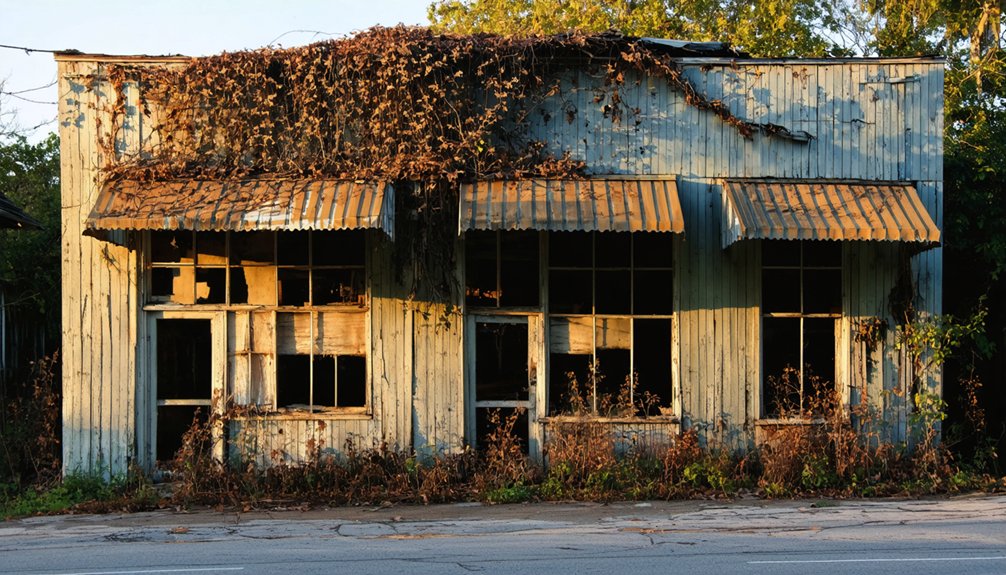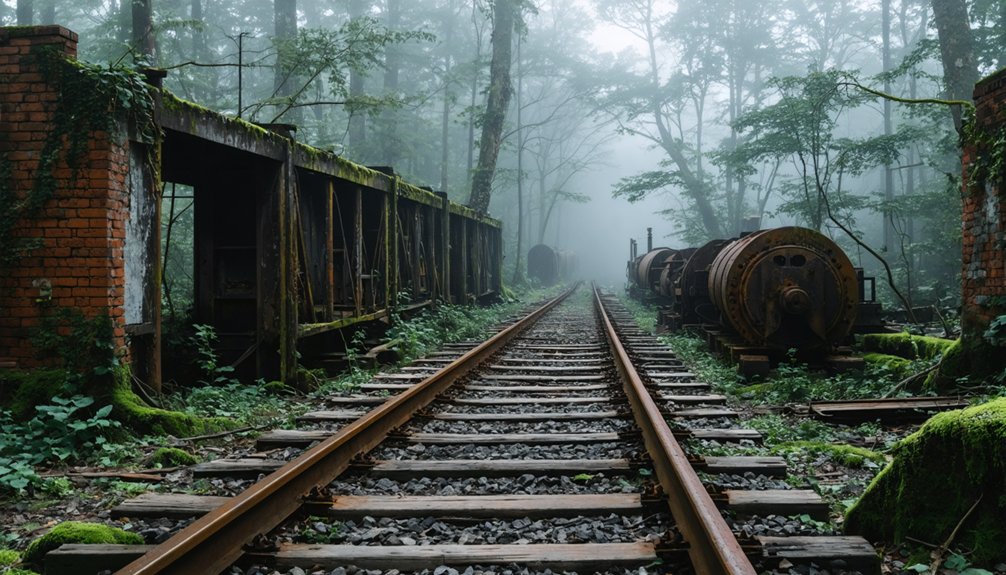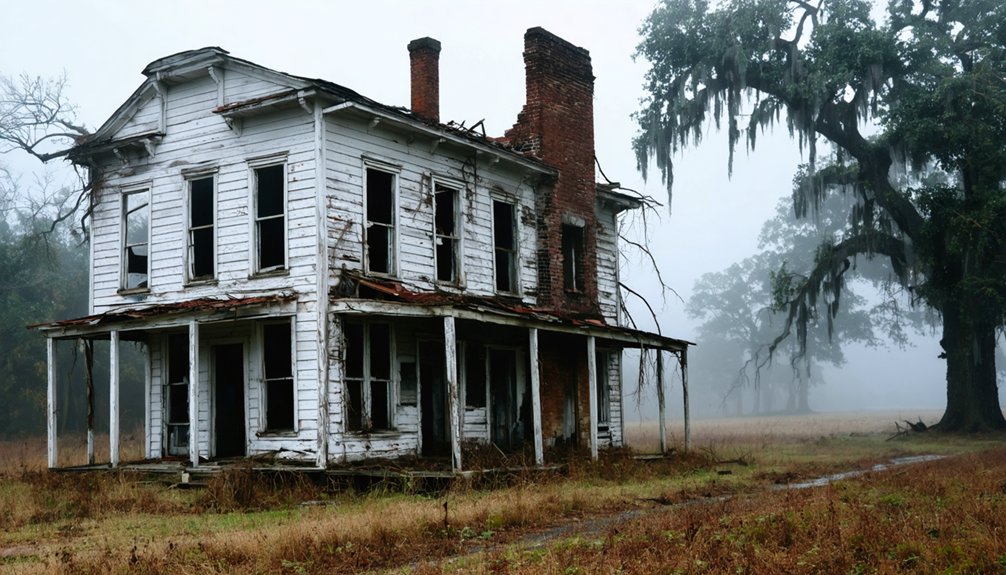You’ll find Oothcaloga’s remains in modern-day Gordon County, Georgia, where this once-bustling Cherokee settlement thrived until 1833. The town centered around a Moravian mission established in 1822, serving as both an educational hub and cultural bridge between Cherokee and European settlers. Federal troops forcibly evacuated the entire community during the Trail of Tears, leaving behind only John Gambold’s grave and scattered historical markers. The town’s dramatic transformation from prosperity to abandonment reveals a pivotal chapter in American history.
Key Takeaways
- Oothcaloga was a thriving Cherokee settlement until 1833, when it was abandoned during the forced removal known as the Trail of Tears.
- The town featured a Moravian mission established in 1822, serving as an educational and religious center for Cherokee youth.
- After gold’s discovery in 1828, white settlers and federal troops forced Cherokee residents from their homes and looted the abandoned settlement.
- The site is now part of Gordon County, Georgia, with only John Gambold’s grave and historical markers remaining as physical evidence.
- The settlement’s original location near Oothkalooga Creek provided strategic advantages and fertile land for the Cherokee community.
The Cherokee Settlement’s Early Days
Three distinct factors shaped Oothcaloga’s emergence as a prominent Cherokee settlement in present-day Georgia.
First, you’ll find its strategic location at the edge of traditional Cherokee heritage lands, where it served as a vital outpost for the tribe’s expanding territory.
Second, the town attracted numerous Cherokee refugees fleeing conflicts in North Carolina during the late 18th century, strengthening its population and influence.
Finally, the region’s fertile land and river access created ideal conditions for sustaining a thriving community.
The settlement’s early governance reflected typical Cherokee town structure, with a central townhouse and plaza serving as the heart of political and religious life.
Drawing from ancient Mississippian traditions, Oothcaloga’s residents maintained complex social systems while adapting to increasing pressures from European-American colonization. The Etowah River Valley provided rich agricultural lands that supported the settlement’s growth and development.
The community’s cultural practices were enriched by the written Cherokee language introduced in 1821, enabling preservation of their traditions and history.
Rise of the Moravian Mission
As Oothcaloga’s Cherokee settlement matured, a significant chapter began in 1822 with the establishment of the Moravian Mission. You’ll find its roots in Joseph Crutchfield’s house, which the Moravians purchased to create an educational and religious center near Oothkalooga Creek.
The Moravian influence flourished under dedicated missionaries like John Gambold and his botanist wife Anna Rosina, who championed both spiritual and practical education. Methodist circuit riders began visiting the area in 1823, establishing their own day schools at the settlement. After Gambold’s passing in 1827, a succession of missionaries including J.R. Schmidt continued the work.
Mission education became a powerful tool in preserving Cherokee culture while preparing youth for leadership roles. You’d have witnessed Cherokee students boarding at the facility, learning literacy, language, and moral principles that bridged both cultures.
The Moravian Mission melded Cherokee traditions with new learning, fostering young leaders who could walk confidently in both worlds.
This cultural exchange continued until 1833, when Georgia’s citizens forced the mission’s closure during the tragic Indian Removal period, though missionary Henry Clauder remained committed to serving the community.
Life at Oothcaloga Mission
When the Oothcaloga Mission opened its doors in 1822, you’d have found a bustling center of cultural exchange where Cherokee students lived and learned alongside Moravian missionaries.
The mission education focused on creating an educated Cherokee elite while balancing spiritual teachings with practical knowledge. Under the leadership of John Gambold, the mission established strong educational foundations until his death in 1827. You’d have witnessed daily routines filled with study, worship, and manual labor, as Cherokee youth immersed themselves in the boarding school experience.
Community interaction flourished as the mission served as a gathering place for both Cherokee and Moravian peoples.
You’d have seen prominent Cherokee families sending their children to study while visitors from across the Cherokee Nation were welcomed with traditional hospitality.
Despite mounting pressures from encroaching settlers, this cultural bridge remained active until its closure in 1833.
The Trail of Tears and Forced Abandonment
The discovery of gold near Oothcaloga in 1828 triggered a devastating chain of events that would ultimately destroy the Cherokee community.
Despite their legal resistance and cultural heritage, you’ll find that Georgia’s land lottery of 1832 and the Indian Removal Act stripped the Cherokee of their ancestral lands. Their resilience couldn’t prevent the tragedy that followed.
- Federal troops forcibly rounded up 15,000 Cherokee at gunpoint
- Families had only moments to gather belongings before being marched to stockades
- White looters ransacked abandoned homes while soldiers watched
- The 800-mile journey west claimed up to 4,000 Cherokee lives
The New Echota Treaty of 1833 sealed their fate, though most Cherokee people considered it fraudulent and refused to acknowledge its terms. The Cherokee Nation had established a formal government system with courts and police, showing their commitment to peaceful coexistence before removal.
Historical Legacy and Present-Day Site
Standing quietly in Gordon County, Georgia, Oothcaloga’s legacy persists primarily through historical markers and archived documents rather than physical structures.
If you visit the site today, you’ll find little evidence of the once-thriving Moravian mission that educated Cherokee children and adults from 1822 to 1833.
John Gambold’s grave, located about 100 yards east of the former mission, stands as the only tangible reminder of this historical significance.
The cultural memory of Oothcaloga lives on through historical societies and researchers who study the complex relationships between Cherokee natives and Moravian missionaries.
You won’t find a modern town bearing the Oothcaloga name, as the area has been absorbed into the broader Gordon County landscape, marked only by its location near Union Grove Road and Interstate 75.
Among the lost landmarks was the Oothcaloga Mill, which stood until its demolition in 1955, marking the end of an era in local industry.
Like the nearby New Echota, this historic site stands as a testament to the Cherokee Nation’s presence in Georgia before their forced removal.
Frequently Asked Questions
What Traditional Cherokee Ceremonies Were Practiced at Oothcaloga Before the Mission?
While you’ll find no direct records of specific ceremonies at Oothcaloga, Cherokee rituals likely included stomp dancing, “going to water” spiritual practices, seasonal celebrations, and ceremonial gatherings around sacred fires with storytelling.
How Many Cherokee Students Attended the Mission School During Its Operation?
Like seeds scattered across fertile ground, you’d find that Cherokee education at Oothcaloga Mission reached over a hundred students during its 11-year run, though exact enrollment numbers aren’t preserved.
What Happened to the Mission’s Original Documents and Religious Artifacts?
You’ll find that the mission’s original documents and artifacts haven’t been clearly traced. While they’re likely preserved in Moravian archives or museums, their exact locations and preservation status remain undocumented.
Were There Any Notable Cherokee Leaders or Figures Born in Oothcaloga?
Like stars in the Cherokee night sky, you’ll find Stand Watie, Major Ridge, John Ridge, and Elias Boudinot were all born in Oothcaloga, shaping Cherokee culture through their leadership and local legends.
Did Any Descendants of Oothcaloga’s Cherokee Residents Ever Return to Visit?
You won’t find documented evidence of descendant visits or family reunions at Oothcaloga. After the 1838 Trail of Tears, most Cherokee descendants established new lives in Oklahoma or North Carolina.
References
- https://www.georgiahistory.com/ghmi_marker_updated/oothcaloga-mission/
- https://en.wikipedia.org/wiki/List_of_ghost_towns_in_Georgia_(U.S._state)
- https://vault.georgiaarchives.org/digital/collection/vg2/id/7868/
- https://dlg.usg.edu/record/dlg_vang_gor318
- https://www.hmdb.org/m.asp?m=60002
- https://www.georgiaencyclopedia.org/articles/history-archaeology/cherokee-indians/m-10917/
- https://www.hmdb.org/m.asp?m=180360
- https://www.georgiahistory.com/ghmi_marker_updated/oothcaloga-valley/
- https://accessgenealogy.com/georgia/native-american-history-of-bartow-county-georgia.htm
- https://georgiatribeofeasterncherokee.org/historial-places



